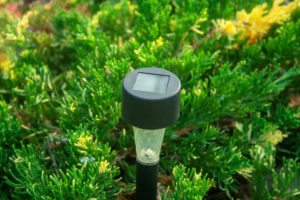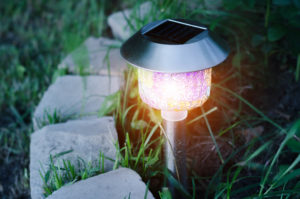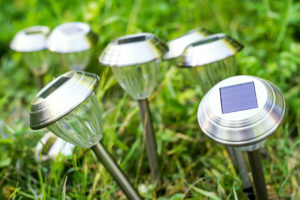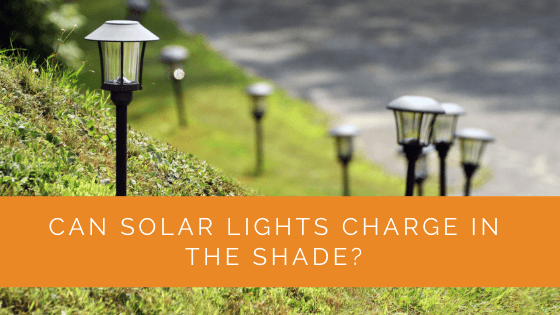Using solar lights is one of the most environmentally conscious decisions you can make today. It is excellent for the environment and comes with many other benefits you could take advantage of.
For instance, outdoor solar lights can help you save large sums on your electricity bill while illuminating your space appropriately. We all know that all a solar light needs is direct sunlight to charge. However, is it possible to recharge your solar lights in the shade?
Find out everything you need about solar-powered lights and how much sunlight they need to recharge!
Contents
- 1 Key Takeaways
- 2 Can a Solar Light Charge in The Shade?
- 3 How Does a Solar Light Work?
- 4 How Does Shade Affect Your Solar Light Efficiency?
- 5 What Is the Optimum Level of Sunlight for Solar Lights?
- 6 How to Charge Your Solar Lights on A Cloudy Day
- 7 Tips to Increase the Efficiency of Rechargeable Batteries
- 8 Case Study: Optimizing Solar Light Charging in Shaded Areas
- 9 Expert Insights From Our Solar Panel Installers About Charging Solar Lights in the Shade
- 10 Our Expertise in Solar Lights
- 11 Conclusion
Key Takeaways
- Solar lights can charge in the shade or on cloudy days, although the charging process may be slower due to reduced sunlight. Solar panels can still absorb diffused sunlight and convert it into electrical energy to recharge the lights.
- The efficiency of solar lights depends on the amount of sunlight they receive. Direct sunlight is optimal for charging, taking around 6 to 8 hours for a full charge, with smaller panels taking longer. Proper positioning of solar panels is crucial to maximize sunlight exposure.
- To charge solar lights on cloudy days or in the shade, consider placing panels away from obstructions, ensuring the correct orientation, using alternate charging methods like power outlets if necessary, and utilizing incandescent bulbs when there’s no access to full sunlight. Additionally, maintaining clean solar panels and occasionally repositioning them can improve efficiency.
Can a Solar Light Charge in The Shade?
Solar lights charge even if no direct sunlight is available. Cloudy weather may block the sun’s rays, so solar lights need to charge. However, small amounts of solar energy penetrate the clouds even in complete shade.
Solar panel cells have no trouble absorbing and converting this light into electrical energy. While the efficiency of the solar cell panel may be reduced on cloudy days, your solar lights will recharge even in the shade.
Shade from the clouds during the day does not always mean complete darkness. Solar panels can recharge their batteries in the shade with as much light as possible. The process may be slower, but it does not mean your solar lights will be discharged entirely for the night.

How Does a Solar Light Work?
To fully understand solar lights, you must first learn about their mechanism. The following are the most critical parts of the solar panel system.
Solar Panels
Solar panels come equipped with photovoltaic cells responsible for absorbing solar energy. The light from the sun directly falls onto the solar panels. This solar energy is then converted to electrical power.
Solar Lights
Solar lights consist of regular LED lamps that run on electricity. The light bulb produces artificial light for your home without using traditional sources of electricity. You can charge solar lights using the energy acquired from the sun, and these light bulbs will provide you with incandescent light at night.
Solar Battery
A solar battery is the one responsible for your outdoor solar lights system. They store power for future purposes.
These batteries charge during the day and then power your light at night. The energy from direct sunlight is converted to electrical energy by the solar panel and stored in the rechargeable battery.
Solar Sensor
Most outdoor solar lights need direct sunlight to charge during the day. Today, these solar lights have sensors that detect sunlight and automatically switch off to recharge their batteries. Once the sun goes down in the evening, the lights automatically switch on and illuminate your home.
How Does Shade Affect Your Solar Light Efficiency?
Solar lights are excellent artificial light sources to install around your property. However, most people have doubts about the reliability of solar lights. The effect of shade on cloudy days can undoubtedly affect the efficiency of your solar light bulbs.
Shade is described when there is an obstruction between the sun’s rays and your solar panel. Clouds, trees, etc., could cause this obstruction. However, if your panels receive adequate light, they will recharge their solar batteries.
A cloudy day or inclement weather will result in reduced electricity production. Your solar panels need photons to convert to electrons; diffused sunlight results in fewer photons, dramatically reducing your energy output.
To increase the energy produced, provide direct sunlight to your solar light and the solar panel system.
What Is the Optimum Level of Sunlight for Solar Lights?
Solar lights need direct sunlight to charge optimally. However, charging solar lights with enough sunlight is not always possible. Depending on the type of solar lights you have and their solar battery capacity, the time required to recharge will vary from one light to another.
Most solar lights take 6 to 8 hours to recharge during the day. This light is stored in the battery and then used at night. A fully charged solar light can produce bright light for about 8 hours and should last you through the night.
The solar panel’s size and position also determine how long your lights will take to recharge. For instance, a small solar panel covers a smaller surface area and will take longer to recharge the battery.
You can install solar lights around your property as your primary household light. However, positioning your outdoor solar lights’ solar panels is crucial so they receive enough sunlight.

How to Charge Your Solar Lights on A Cloudy Day
Solar lights work best when adequately charged and receive as much sunlight as possible. You can charge solar lights during the day, even in indirect sunlight or on cloudy days.
This is possible if you strategically position your solar garden or other solar lights.
Here are a few tips to help you make this process easier.
Place Your Panels Away from The Shade
Today, most solar lighting comes with panels not attached to the light. This enables you to place your solar lights anywhere you like. You can position the panels away from the light in the open and avoid all obstruction.
This way, your solar panels receive more sunlight and are fully charged by nightfall. You can also avoid obstructions like bushes and tall trees that can hinder the direct sunlight.
Make Sure the Orientation of The Solar Panel Is Correct
If you live in a region that receives a ton of rainfall, you need to maximize the sunlight you get during the day. The orientation of your panels is essential if you want the full sunlight benefits.
Ensure you tilt the panels at an angle so that sunlight falls directly on them during the day. Solar-powered lights do not usually come with automatically tilting solar panels, so you must ensure the most efficient angle.
Try an Alternate Charging Method
Solar lights are essentially LED lights that require electricity to run efficiently. Solar panels with good battery capacities can ensure your solar lights stay on overnight. However, these lights can also produce bright light with the help of alternate charging sources.
You can charge solar lights from a power outlet if needed. Many solar lights work with the help of both solar energy and traditional electricity from outlets. However, this alternative must be used in dire situations only.
Use Incandescent Bulbs
Solar cells are built to respond to light of a specific wavelength. An incandescent bulb is an excellent source of artificial lighting that can be used to charge solar lights. You can charge solar lights using incandescent light if there is complete darkness and no other light is available.
LED light is different from incandescent bulbs and requires significantly less energy. The use of these bulbs may seem counterproductive. However, incandescent light is your safest option when you cannot access full sunlight.
Tips to Increase the Efficiency of Rechargeable Batteries
Shade is one of the most significant factors resulting in the reduced efficiency of solar lighting. However, you can do the following to ensure your solar batteries store enough energy to power your solar light through the night.
Clean the Solar Panels
Keep your solar panels free of dust and debris. Obstructions like these can also reduce the amount of solar energy your panels receive. This will lower efficiency, and your lights will take longer to recharge.
Use Mirrors
If your solar lights have small panels, you can use mirrors to increase the amount of light falling on them. Install mirrors around your solar panel and redirect all light to the panel.

Switch Off Your Solar Lights Manually
You can charge your solar lights efficiently by switching them off manually. Keep these lights off for about 72 hours and let them recharge completely. Once fully charged, you can switch them on and let the light sensors do their job.
Reposition the Panels
If you have moveable solar panels, you can reposition them occasionally. The sun’s position changes throughout the year, and if a particular angle is not working for your lights, you can change it to optimize sunlight absorption.
Case Study: Optimizing Solar Light Charging in Shaded Areas
Background
At Solar Panels Network USA, we are committed to helping homeowners maximize the efficiency of their solar lighting systems, even in less-than-ideal conditions. This case study demonstrates how strategic positioning and maintenance can ensure solar lights charge effectively, even in shaded areas.
Project Overview
A homeowner living in a heavily wooded area faced challenges with their outdoor solar lights not charging adequately due to limited direct sunlight. The primary goal was to optimize the charging process and ensure the lights could function effectively throughout the night.
Initial Consultation and Assessment
Understanding the Problem
During our consultation, the homeowner explained that their solar lights were placed in areas with significant tree cover, leading to poor charging performance and dim lighting at night.
On-Site Inspection
Our team conducted a thorough site inspection to assess the positioning of the solar panels and identify potential obstructions. We evaluated the angles of the panels and the surrounding environment to determine the best strategy for optimizing sunlight exposure.
Implementation
Strategic Repositioning
Based on our assessment, we recommended repositioning the solar panels to maximize exposure to available sunlight. We identified spots with the least amount of shade throughout the day and adjusted the panel angles accordingly.
Using Reflective Surfaces
To enhance light absorption, we suggested using reflective surfaces, such as mirrors, to redirect sunlight onto the solar panels. This strategy helped increase the amount of light reaching the panels, even in shaded conditions.
Panel Cleaning and Maintenance
We advised the homeowner on the importance of regular maintenance, including cleaning the solar panels to remove dust and debris. A clean surface ensures maximum light absorption and improved charging efficiency.
Results
Improved Charging Performance
After repositioning the panels and incorporating reflective surfaces, the solar lights showed a marked improvement in charging performance. Even on cloudy days, the lights gathered enough energy to remain illuminated throughout the night.
Enhanced Light Output
The optimized charging process resulted in brighter and more reliable lighting. The homeowner reported a significant difference in the light output, with the solar lights providing consistent illumination from dusk until dawn.
Sustained Efficiency
Regular maintenance, including cleaning the panels and adjusting their positioning as needed, ensured sustained efficiency. The homeowner was pleased with the long-term reliability and performance of their solar lighting system.
Summary
Our expertise in solar lighting solutions enabled us to develop and implement an effective strategy for optimizing solar light charging in shaded areas. By repositioning the panels, utilizing reflective surfaces, and emphasizing regular maintenance, we significantly improved the performance and reliability of the solar lights. This case study highlights the importance of strategic placement and upkeep in maximizing the efficiency of solar lighting systems, even in challenging conditions.
Expert Insights From Our Solar Panel Installers About Charging Solar Lights in the Shade
Even on cloudy days, solar lights can still charge. The solar panels are designed to absorb diffused sunlight, which means your lights can gather energy even without direct sun exposure.
Lead Solar Engineer
Proper positioning of your solar panels is crucial. Placing them in an area with minimal obstructions will help maximize the available sunlight, ensuring your lights remain charged and functional.
Senior Solar Technician
Maintaining clean solar panels is essential for efficiency. Dust and debris can block sunlight and reduce charging capacity, so regular cleaning is a simple yet effective way to keep your solar lights working optimally.
Renewable Energy Specialist
Our Expertise in Solar Lights
At Solar Panels Network USA, we’re here to provide you with valuable information and support regarding solar lighting. With our experience and understanding of the solar lighting industry, our team of experts is prepared to assist you in finding the right lighting solution for your needs. Whether you’re interested in improving your outdoor spaces, conserving energy, or adopting a more sustainable approach, we’re well-equipped to help. Please feel free to contact us with any questions or inquiries.
Conclusion
Solar lights are a reliable solution to illuminating your homes. You can recharge these lights even without direct sunlight and use them overnight. All you need to do is ensure the panels are clean and positioned correctly in the open.
A solar panel receives sunlight during the day, even when cloudy. So, ensure you do not give up on your outdoor lighting system when the sun isn’t shining as brightly as usual!
About the Author
Solar Panels Network USA stands at the forefront of solar energy solutions, driven by a team of seasoned solar engineers and energy consultants. With over decades of experience in delivering high-quality solar installations and maintenance, we are committed to promoting sustainable energy through customer-centric, tailored solutions. Our articles reflect this commitment, crafted collaboratively by experts to provide accurate, up-to-date insights into solar technology, ensuring our readers are well-informed and empowered in their solar energy decisions.

